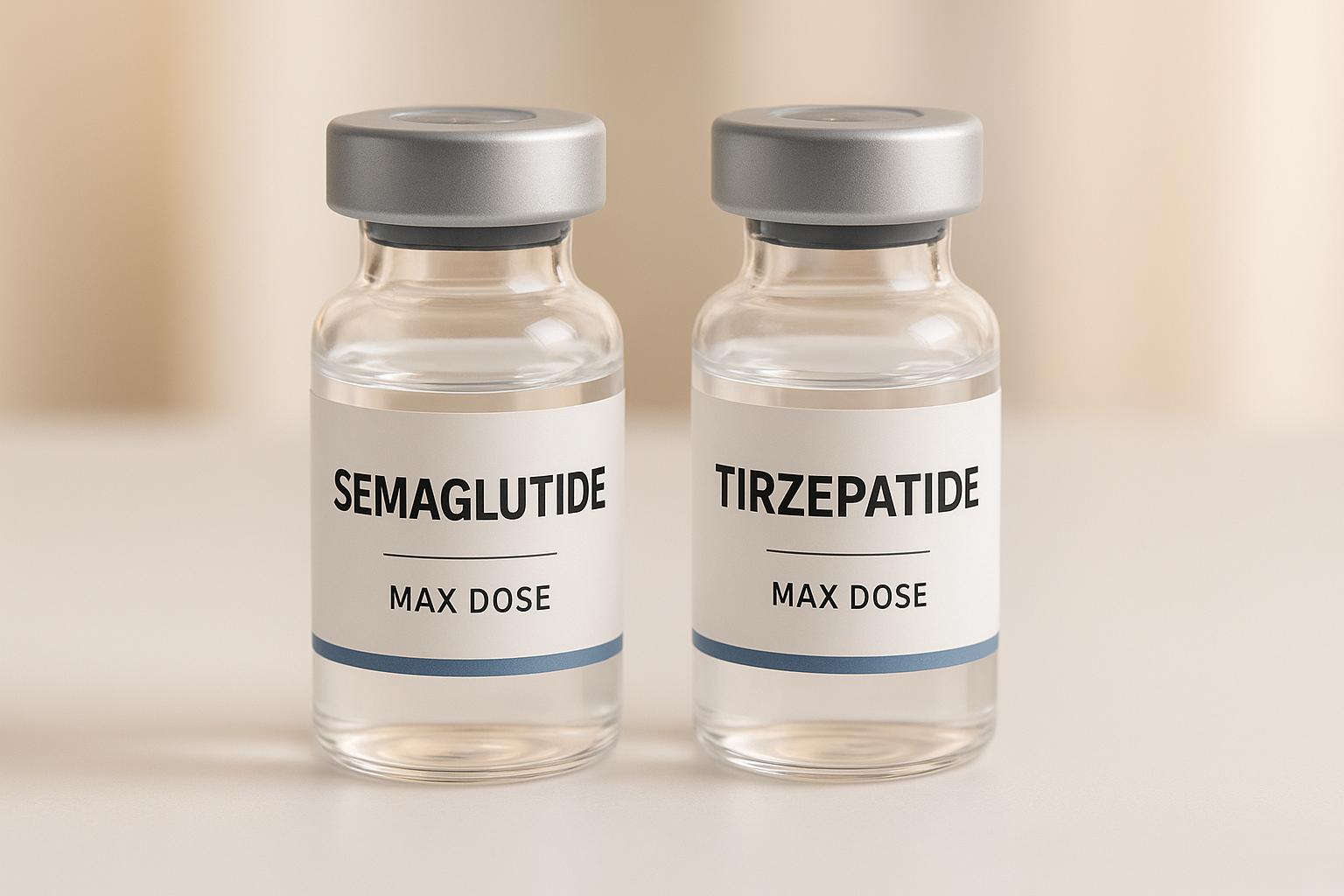Semaglutide vs. Tirzepatide: Max Dose

When it comes to weight loss, Semaglutide and Tirzepatide are two leading medications with different maximum doses and outcomes. Semaglutide’s weekly max dose is 2.4 mg, while Tirzepatide goes up to 15 mg. Both require gradual dose increases to reduce side effects like nausea or vomiting.
Here’s the key difference: Tirzepatide typically results in greater weight loss. Clinical trials show an average weight reduction of 20.2% with Tirzepatide compared to 13.7% with Semaglutide. Tirzepatide also uses a dual-action mechanism for more pronounced effects, while Semaglutide focuses on a single pathway. However, Semaglutide offers proven cardiovascular and kidney benefits, which may make it a better option for certain individuals.
Quick Comparison
| Feature | Semaglutide (2.4 mg) | Tirzepatide (15 mg) |
|---|---|---|
| Average Weight Loss | 13.7% (33 lbs) | 20.2% (50.3 lbs) |
| Mechanism | GLP-1 receptor only | GLP-1 + GIP receptors |
| FDA Approval for Weight Loss | Yes | Yes (as of Nov 8, 2023) |
| Cardiovascular Benefits | Proven | Under investigation |
| Side Effects | Nausea, vomiting, diarrhea | Similar, but may vary |
| Weekly Cost (Starting) | $199 | $349 |
Both medications are effective, but the right choice depends on your goals, health history, and how well you tolerate side effects. Consult your healthcare provider to determine the best option for you.
Comparing Semaglutide vs Tirzepatide for Weight Loss in Adults with Obesity: JAMA Study
Semaglutide Maximum Dose
Semaglutide, approved by the FDA for weight management, is gradually increased to its full maintenance dose. This step-by-step approach helps the body adapt to the medication while reducing the risk of side effects. The process typically takes about 16 weeks to complete. Below is a closer look at how the dosing works and what to expect.
How the Dose Is Increased
Treatment begins with a low starting dose, which is gradually increased each week over a 16-week period. Adjustments to this schedule may be made by healthcare providers based on how well the individual tolerates the medication.
What Happens at the Maximum Dose
Once the maximum dose is reached, Semaglutide is most effective for weight management. While some individuals may see results earlier in the process, it’s essential to follow your healthcare provider’s instructions to achieve the best outcomes.
Tirzepatide Maximum Dose
Tirzepatide, sold under the name Zepbound, is a once-a-week injection administered subcutaneously, with the highest FDA-approved dose set at 15 mg. This dose is gradually increased over time to help reduce gastrointestinal side effects. The medication received FDA approval for chronic weight management in adults with obesity on November 8, 2023[1]. Let’s take a closer look at how the dosing is adjusted and what results can be expected at the maximum dose.
Increasing Tirzepatide Dose
Your healthcare provider will create a personalized plan to gradually increase your dose of Tirzepatide, adjusting based on your individual response to the treatment. The injections are typically given in the thigh, abdomen, or upper arm, and it’s important to stick to the same day each week for consistency.
Outcomes at the Maximum Dose
Once patients reach the 15 mg weekly dose, the benefits of the treatment become much more noticeable. According to data from the 72-week SURMOUNT-1 trial, participants on the maximum dose experienced an average weight loss of 18% of their body weight, with 36.2% achieving a significant reduction in weight[1].
These results tend to become more pronounced after several months of maintaining the maximum dosage, offering not just weight loss but also improvements in overall metabolic health.
[1] SURMOUNT-1 trial data and FDA approval documentation.
How They Compare at Maximum Doses
When it comes to managing weight effectively, understanding how these medications perform at their maximum doses is key. Clinical trials reveal that while both drugs result in significant weight loss, Tirzepatide tends to deliver more pronounced outcomes for a larger number of patients.
Comparison Table: Semaglutide vs. Tirzepatide Results
| Metric | Semaglutide (2.4 mg) | Tirzepatide (15 mg) |
|---|---|---|
| Average Weight Loss | Noticeable reduction in weight | Greater reduction in weight |
| Patients Achieving ≥10% Weight Loss | High percentage of patients | Slightly higher percentage |
| Patients Achieving ≥15% or ≥20% Weight Loss | Moderate proportion | Larger proportion |
| Trial Duration | Multi-month controlled studies | Similar trial duration |
| Weekly Injection Frequency | Once weekly | Once weekly |
| Time to Reach Maximum Dose | Around 16–20 weeks | Comparable timeframe |
Main Differences in Effectiveness
While the table provides a quick snapshot, let’s dive into why these differences exist.
One of the standout factors is Tirzepatide’s dual-action mechanism, which targets both GLP-1 and GIP receptors. This combined approach boosts its effectiveness, helping more patients reach ambitious weight loss milestones. On the other hand, Semaglutide works through a single pathway, focusing only on GLP-1 receptors. The result? While effective, it doesn’t quite match the outcomes seen with Tirzepatide.
Both medications require several months to reach their peak effects. However, patients on Tirzepatide often report a steeper decline in body weight by the end of the treatment period compared to those using Semaglutide. The differences in how these drugs work at a molecular level are clearly reflected in the clinical results.
sbb-itb-e2779c3
Safety at Maximum Doses
When using Semaglutide or Tirzepatide at their highest recommended doses, understanding their safety profiles is essential. While these medications deliver notable results, safety considerations remain a top priority.
Side Effects of Semaglutide and Tirzepatide
Common side effects for both drugs include nausea, vomiting, and diarrhea, though the intensity and frequency can differ between the two. Rare complications, such as gallbladder issues or pancreatitis, may also arise. Symptoms like severe abdominal pain or persistent nausea should prompt immediate medical attention.
Although hypoglycemia is uncommon when these medications are used on their own, it becomes a concern for patients taking other diabetes treatments simultaneously. Monitoring blood sugar levels in such cases is crucial.
Tips for Managing Side Effects at Higher Doses
To minimize side effects, gradual dose increases are recommended. Starting at lower doses and slowly escalating over several weeks helps the body adjust. Timing and dietary changes can also make a difference:
- Eat smaller, frequent meals to ease gastrointestinal discomfort.
- Avoid foods that are fatty, greasy, or spicy, as they can worsen symptoms.
- Some patients find relief by consuming bland foods before their injection.
Adjusting the timing of injections may also help. Taking the injection in the evening can allow some individuals to sleep through periods of discomfort, while others may prefer morning doses to avoid sleep disturbances.
If side effects become too difficult to manage, a temporary dose reduction might be suggested by your healthcare provider. This gives your body time to adjust before attempting to increase the dose again. For persistent nausea or vomiting, short-term use of antiemetics may be recommended. Staying well-hydrated can also alleviate gastrointestinal symptoms.
Regular check-ins with your healthcare provider are key. They can monitor your progress, adjust your treatment plan as needed, and help you safely reach and maintain the maximum dose while managing any side effects effectively.
Finding the Right Maximum Dose for You
Once safety is addressed, the next step is figuring out the dose that works best for you. Not everyone needs the highest dose to see results. Some people achieve their weight loss goals with moderate doses, while others might need to increase their dosage if progress slows down.
Your healthcare provider will assess various factors to decide if a higher dose is necessary. For instance, if your weight loss hits a plateau, they may suggest gradually increasing the dosage. Factors like your starting weight, metabolism, daily habits, and genetics all play a role in how your body responds. This personalized approach ensures the treatment remains safe and effective, helping you stay on track.
Custom Weight Loss with TrimRX

Tailored support is essential when determining the right dose for you, and TrimRX offers a personalized approach to GLP-1 medication dosing. They understand that a one-size-fits-all plan doesn’t work for everyone. Their medical team conducts in-depth consultations to evaluate your specific needs, medical history, and weight loss goals. From there, they recommend a starting dose and create a custom plan for gradual dose adjustments.
TrimRX provides dosing plans for both Semaglutide and Tirzepatide, starting at $199 for Semaglutide and $349 for GLP-1/GIP injections. They also include ongoing support and free delivery to make dose adjustments easier as your progress is monitored. With unlimited check-ins with healthcare providers, you’ll receive consistent guidance to find the dose that works best for you – whether that’s a moderate level or the maximum dose.
What Affects Dose Selection
Several factors influence how healthcare providers determine your ideal dose. These include your weight loss goals, tolerance for side effects, medical history, current medications, rate of progress, age, and overall health.
For example, if you experience ongoing nausea or digestive discomfort with a moderate dose, your provider might suggest staying at that level longer before considering an increase. Some people find their best results at a lower dose, which can also help minimize the risk of side effects associated with higher doses.
Your medical history and any medications you’re taking play a big role as well. Patients with diabetes or those on drugs that affect blood sugar levels may require a more cautious approach to dose adjustments to avoid complications.
If you’re seeing steady progress with a moderate dose, your provider might recommend sticking with it rather than increasing the dosage. However, if your weight loss stalls for several weeks, they may suggest a gradual increase to reignite progress.
The ultimate goal is to find the lowest effective dose that delivers consistent weight loss with manageable side effects. Regular check-ins and open communication with your healthcare provider are key to striking this balance.
Final Thoughts: Semaglutide vs. Tirzepatide at Maximum Doses
Now that we’ve covered dosing strategies and safety profiles, let’s take a closer look at how these medications stack up when used at their maximum doses. Both offer substantial weight loss benefits, but they achieve results in different ways, leading to distinct outcomes.
According to the extensive 72-week SURMOUNT-5 study, which included over 18,000 adults with obesity, Tirzepatide consistently outperformed Semaglutide in terms of weight loss at maximum dosage. The study showed that Tirzepatide users experienced an average weight loss of 20.2% (about 50.3 lbs), compared to 13.7% (33 lbs) with Semaglutide.
"Overall, evidence from clinical research supports that Tirzepatide may provide a more potent option for weight reduction in adults with obesity, surpassing Semaglutide in both overall weight loss percentages and related health benefits."
– Pharmko
Tirzepatide’s dual-action mechanism not only enhances weight loss but also improves blood sugar control, reducing A1C levels by 2% to 2.5%. In comparison, Semaglutide lowers A1C by 1% to 2%.
On the other hand, Semaglutide has well-documented cardiovascular benefits. It’s FDA-approved for lowering the risk of heart attack, stroke, and heart-related death in individuals with type 2 diabetes or obesity who have existing heart disease. It also helps reduce the risk of worsening kidney disease. While Tirzepatide’s cardiovascular impact is still under investigation, this could be a key factor for those with preexisting heart conditions.
Main Points to Remember
Here are the highlights to consider when comparing these medications:
- Tirzepatide leads to more significant weight loss results, with nearly half of users achieving over 20% weight loss and more than 80% losing at least 5% of their body weight.
- Semaglutide provides proven cardiovascular and kidney protection, making it a strong choice for individuals with specific health concerns.
- Cost considerations: Programs like TrimRX offer Semaglutide starting at $199, while dual-action GLP-1/GIP injections, like Tirzepatide, start at $349.
- Personal outcomes depend on factors such as starting weight, metabolism, medical history, and how well side effects are tolerated.
Ultimately, choosing the right medication requires careful, personalized guidance. Working with a healthcare provider who understands your unique needs and can monitor your progress is key to achieving long-term, sustainable weight loss.
FAQs
What are the differences in how Semaglutide and Tirzepatide work, and how do these impact weight loss results?
Semaglutide works by imitating the GLP-1 hormone, which plays a role in managing appetite and blood sugar levels. Tirzepatide, however, takes it a step further as a dual agonist, targeting both GLP-1 and GIP receptors. This combined approach may boost its effectiveness in promoting weight loss by improving insulin sensitivity and curbing hunger even more effectively.
Both medications have shown success in supporting weight management, but tirzepatide’s dual-action mechanism could result in greater weight loss for some people. Choosing the right option depends on your individual health goals and needs, which can be determined through a tailored weight loss plan.
What are the best ways to manage common side effects when taking the maximum dose of Semaglutide or Tirzepatide?
Managing side effects at the highest dose of Semaglutide or Tirzepatide often requires addressing mild to moderate issues like nausea, diarrhea, or vomiting. These symptoms are most common during dose adjustments and usually improve as your body adjusts to the medication.
If side effects become more severe, such as ongoing gastrointestinal problems, it’s crucial to reach out to your healthcare provider. They might suggest slowing down the dose increase, modifying your treatment plan, or keeping an eye on kidney function, especially if dehydration becomes a concern. Simple steps like staying well-hydrated and opting for smaller, lighter meals can also go a long way in easing discomfort.
How do Semaglutide and Tirzepatide compare for individuals with cardiovascular conditions?
The use of Semaglutide and Tirzepatide offers potential advantages for people with existing cardiovascular conditions, though the outcomes can depend on individual health factors and treatment objectives. Both medications are effective in promoting weight loss and improving blood sugar levels, but their impact on heart health may not be identical. Research indicates that GLP-1 receptor agonists, such as Semaglutide, might also help lower the risk of certain heart-related events for some patients.
To decide which option is best suited for you, it’s essential to consult with a healthcare provider. Programs like those provided by TrimRX can create personalized treatment plans that align with your specific health needs and goals.
Related Blog Posts

Transforming Lives, One Step at a Time
Keep reading
Ultimate Guide to Semaglutide Dose Customization
This guide explores semaglutide dosing for diabetes and weight loss, emphasizing personalized adjustments for optimal results.
6 Common Drug Interactions with GLP-1 Medications
Learn about six common drug interactions with GLP-1 medications and how to manage potential risks for safe treatment.
Mounjaro Insurance Coverage: What to Know
Learn how insurance coverage for Mounjaro varies based on diabetes treatment and weight loss, along with tips for approval and cost-saving options.
GLP-1 Diet Plan: 7-Day Meal Guide
Learn how to effectively pair GLP-1 medications with nutritious meal planning for weight loss, improved digestion, and stable blood sugar.
Nausea and GLP-1 Medications: Solutions That Work
Learn effective strategies to manage nausea from GLP-1 medications, including dietary tips and the importance of personalized dosing.
5 Signs GLP-1 Medication Is Working for You
Learn the key signs that indicate your GLP-1 medication is effectively aiding weight loss, appetite control, and blood sugar management.
Plateau Problems: Restarting Weight Loss
Stalled weight loss on GLP-1 medications is common but manageable. Explore strategies to break through plateaus and regain momentum.
Body Fat Percentage Estimator – Know Your Stats
Estimate your body fat percentage in seconds with our free tool. Just input your height, weight, and more for instant results. Try it now!
Wegovy vs Ozempic: Complete Comparison
Explore the differences between two popular medications for weight management and diabetes, including dosing, side effects, and effectiveness.









